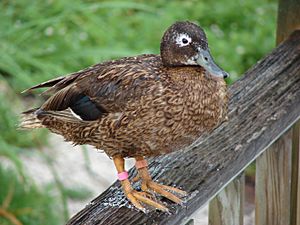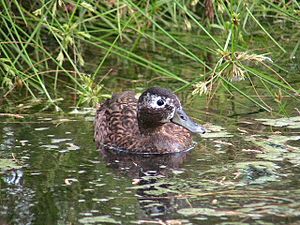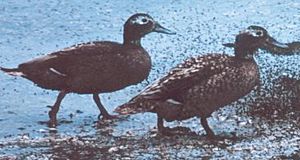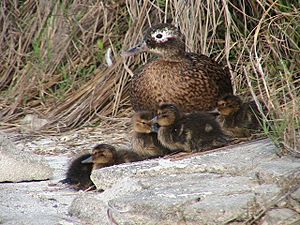Laysan duck facts for kids
Quick facts for kids Laysan duck |
|
|---|---|
 |
|
| Bird at Midway | |
| Conservation status | |
| Scientific classification | |
| Genus: |
Anas
|
| Species: |
laysanensis
|
 |
|
| Distribution map of the Laysan duck | |
The Laysan duck (Anas laysanensis), also called the Laysan teal, is a special type of dabbling duck. It lives only in the Hawaiian Islands. Long ago, these ducks lived all over the islands. Today, they are found only on Laysan Island and two other small islands.
These ducks have unique features because they evolved without many ground predators. By 1860, they were only found on Laysan Island. In the late 1800s, European rabbits were brought to the island. These rabbits almost caused the ducks to disappear completely by 1912. Only twelve Laysan ducks were left.
Luckily, the rabbits were removed from the island in 1923. The number of Laysan ducks slowly grew, reaching 500 by the 1950s. To help protect them, 42 ducks were moved to Midway Atoll in 2002. They did very well there. Later, more ducks were moved to Kure Atoll.
Contents
What is a Laysan Duck?
Naming and Family Tree
The Laysan duck was named by Lionel Walter Rothschild in 1892. It gets its name from Laysan Island, one of the Northwestern Hawaiian Islands. This duck is part of the mallard family of dabbling ducks. It is a very unique species. Scientists believe it came from an ancient mallard ancestor from East Asia.
How to Spot a Laysan Duck
Appearance
The Laysan duck is about the size of a teal. It is dark brown with a clear white ring around its eyes. Its bill is short and flat. Male ducks have a dark green bill with black spots. Female ducks have a dull orange bill with black spots.
Many Laysan ducks have a ring of fat around their neck. Some males have a slight shiny look on their head or neck. Their central tail feathers might also turn up a little. Both male and female ducks have a shiny purplish-green patch on their wings. This patch is called a speculum.
Older ducks often have more white feathers on their head and neck. Their legs and feet are orange, usually brighter in males. Once a year, these ducks lose all their flight feathers. They cannot fly until new feathers grow back. In the wild, Laysan ducks can live up to twelve years. In zoos, they can live up to eighteen years.
Laysan Duck Behavior
Daily Life and Food
The Laysan duck is not a strong flyer. However, it walks and runs very well. Its body is made for finding food on the ground. When chased, it prefers to stay still instead of flying away.
These ducks are good at catching brine flyes. They run quickly through swarms of flies, snapping them up with their bills. They also find food in shallow lake areas and on the shore. They eat small creatures, algae, leaves, and seeds.
During the day, especially when breeding, they hide in tall grass and bushes. This helps them avoid flying predators like frigatebirds. They usually come out to feed in open areas from dusk until dawn. How much they feed in the open can change each year, depending on how much food is available.
Reproduction and Life Cycle
Laysan ducks start forming pairs in the fall. They begin building nests in the spring. The female builds a hidden nest on the ground. She uses dense plants, especially Eragrostis variabilis grass. The nest is a shallow bowl lined with dead grass and soft feathers.
Ducks usually lay eggs from April to August. On Laysan Island, a female typically lays about four eggs. The ducks on Midway Atoll lay more eggs. This is probably because there is more food available there.
Baby ducks, called ducklings, can feed themselves just two days after hatching. But the mother duck protects them. She keeps them warm and leads them to places to find food. She does this for about 40 to 60 days.
Protecting the Laysan Duck
Why They Almost Disappeared
The number of Laysan ducks started to drop between AD 400 and 1000. This happened when Polynesians came to the Hawaiian Islands. They brought new animals that hunted the ducks. By 1860, the ducks were only found on Laysan Island. This was likely because of rats brought to other islands.
Like many island animals, the Laysan duck grew up without ground predators. So, it was not good at defending itself against new hunters. These included humans, rats, pigs, and small Asian mongooses. For example, Laysan ducks often freeze when scared. This works against flying predators but not against animals on the ground. The Laysan duck can still fly, but not very well or for long distances. It does not fly between islands.
Laysan Island became a protected area in 1909. It was named the Hawaiian Islands National Wildlife Refuge. However, domestic rabbits caused huge damage to the island's plants. This led the duck to the edge of extinction in 1912. Only seven adult ducks and five young ducks were left.
How They Recovered
After many rabbits starved and the rest were removed in 1923, the ducks began to recover. Their population grew to about 500 by the 1950s. In 1967, the Laysan duck was listed as an endangered species. This gave it federal protection.
Sometimes, the population still faced challenges. For example, a severe drought in 1993 reduced the number of ducks to about 100. Today, scientists closely watch how the birds breed and survive. Since 1998, some ducks have been given leg bands or radio transmitters. This helps track their success. It shows that usually only 30% of ducklings on Laysan Island survive to fly. In 2004, the population was about 576 ducks.
In 2004 and 2005, 42 Laysan ducks were moved to Midway Atoll. This was done by the United States Geological Survey and United States Fish and Wildlife Service. The goal was to create a second group of ducks in the wild. Having two groups reduces the risk of extinction. If a disaster like a drought or disease hits one island, the other group can survive.
The second group of Laysan ducks on Midway grew quickly. It more than doubled in size in the first two years. By January 2007, 100 ducks lived on Midway's Sand and Eastern Islands. Researchers found that these ducks bred earlier and laid more eggs. This suggests that the good habitat and food on Midway helped them reproduce more. This gives hope for the success of this new population. A third group has now been moved to Kure Atoll.
Future Hopes for the Laysan Duck
The future of the Laysan duck looks promising right now. But there are still dangers. New species brought to the islands can harm the ducks. They might change how the ducks live or take away their nesting and feeding spots. Damage to plants could also fill the lakes with dirt. These lakes are important for finding food.
Human activity can disturb nesting ducks. Permits to visit Laysan Island are only given for official or scientific reasons. Trash and pollution from the ocean can also be a threat. Pesticide containers and oil spills have harmed Laysan in the past.
The islands where the ducks live are very sensitive to rising sea levels. Extreme weather from global warming is also a risk. Even a small rise in sea level could destroy much of the duck's home. Diseases from other birds, like avian influenza or avian malaria, could also spread.
The U.S. Fish and Wildlife Service has a plan to help the Laysan duck. The goal is to help the species recover. They want to move it from "endangered" to "threatened." Eventually, they hope the population will be healthy enough not to need federal protection.
The plan focuses on creating more healthy groups of ducks. This will lower the risk of a single disaster wiping out the species. More ducks mean they are safer from unexpected problems. Biologists plan to set up at least five groups of ducks. Some will be on predator-free islands. Others will be on islands where predators are controlled. This plan includes moving wild ducks and starting a breeding program. They also want to make sure ducks can move between islands. This helps keep the duck population strong. If the plan works, the Laysan duck could be moved from endangered to threatened by 2019.
See also
 In Spanish: Ánade de Laysán para niños
In Spanish: Ánade de Laysán para niños
Images for kids










